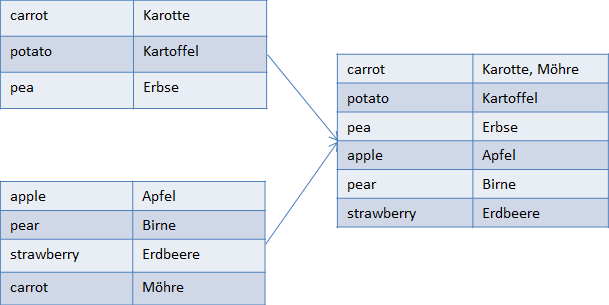Merging Homonyms and Synonyms
Let's add some complication. As a refresher: Homonyms are words that look the same, but have different meaning. Synonyms are different translations for the same word. The examples show you what you get for these cases.
Synonyms in the Target
a.k.a. different translation, same meaning. They are no problem, multiple translations from different termbases just get merged into one, like the two German words for carrot.

Synonyms in the Source
a.k.a. different word, same meaning. If you have synonyms in the source language, (the language you chose as the merging field), things won't work out, and you get not enough merging. The converter doesn't know meanings, so it only merges identical words. Everything that looks different will go to a different entry. Take for example these near identical US and UK termbases. trunk and boot will not be merged, even though they mean the same:

Homonyms
a.k.a. same word - different meaning. As mentioned in the overview, these are also problematic. Again, the software does not understand anything, and if it sees the same word twice, it merges. You get too much merging. See Merging with a Master Termbase and Using a Field Instead of a Language for ways of improving the situation.
In the example below, a lock in a door is not the same as a lock in a canal, but the terms get merged anyway.

.
Created with the Personal Edition of HelpNDoc: Free EPub and documentation generator